Abstract
Geophytes are an increasingly widely used group of plants. Its high biodiversity, however, significantly impacts the cultivation process. Therefore, every new insight into the behavioral aspects of each single species is crucial for production. This study, for the first time, aims at contributing to a better understanding of the interplay between the bulb size potential of Narcissus poeticus and the pattern of bulb lifting time to find the optimal combination of these factors in obtaining the best quality propagation material. Twelve bulb size groups were examined. Plants were planted in the open air in two locations of Central East Europe and lifted in three terms: immediately and two and four weeks after flowering. Bulb fresh and dry weight, as well as leaf, root and total plant dry weight, increased with growing bulb size and delayed the time of lifting. The bulb weight increase indicator was twice as high for bulbs lifted in the third date compared to those lifted earlier. Its value was the highest for the smallest bulbs. Bulb shape ratio gradually decreased together with the increase of bulb weight and later lifting term. Principal components analysis allowed singling out two principal components that accounted for 86.58% of total variability.
1. Introduction
Species belonging to the genus Narcissus (Amaryllidaceae) are known and appreciated ornamental plants worldwide. The most popular are cultivars of the Pseudonarcissus section (e.g., N. pseudonarcissus L.) and Hermione section (N. tazetta L.) [1,2]. Narcissus poeticus cultivars have been cultivated as ornamentals since the beginning of the 20th century and nowadays are still clearly desirable because of their unique decorative and sensory values. The species is included in the Narcissus section [1]. It is characterized by the latest flowering date within the genus, pure white perianth segments and a very short light-yellow corona with a distinct reddish edge. N. poeticus is a spring-flowering plant, producing usually one fragrant flower (uncommon feature) per stem [3]. The species shows a high horticultural potential. Its use as an ornamental bulbous plant for growing in the ground, containers or cut flowers is not the only one. In plant breeding programs, N. poeticus is a parent form in obtaining multi-flowered hybrids and large-cupped narcissi [4]. It found an application in the pharmaceutical industry as a source of biologically active compounds, such as alkaloids, including galantamine [5], which alleviates the symptoms of Alzheimer’s disease [6]. Bulbs of Narcissus poeticus are also a source of narpoetan—a growth-stimulating substance recommended for pre-sowing treatment of spiked cereals and cotton in order to stimulate seedlings growth [7]. The invigorating scent of the absolute extracted from N. poeticus flowers is widely used in the perfume industry [8,9], aromatherapy and hortitherapy. The species also plays an important role in maintaining biodiversity, being a signaling device for pollinators—mainly bees [10]. The genus Narcissus is found primarily in Southwestern Europe, North Africa and the Balkans (e.g., N. poeticus) [1,8]. The wide area of occurrence of narcissus indicates high adaptability of the genus, which can be used to maintain biodiversity, being the basis for the sustainability of ecosystems and human health.
Various localizations, ipso facto environmental field conditions (temperature, light, moisture), may affect geophytes growth at every stage of plant development [11,12]. In addition, the bulb yield and quality vary depending on the initial bulb size [13,14,15,16] and lifting time of the bulbs [17,18]. According to Hanks [19], the number of bulbs in a mixed bulb-size group of Narcissus pseudonarcissus increases 1.6-fold annually. Özel and Erden [16] showed that the bigger the initial bulb size, the higher the final bulb weight and yield of Narcissus tazzeta. However, it should be emphasized that the relationship between the size of bulbs and plant vigor is not simple, and it varies with the genotype; thus, basic research dedicated to the individual species must be undertaken to obtain the best quality bulbs for particular utilization [20]. In the case of Narcissus pseudonarcissus, the annual planting and lifting methods were effective to optimize the bulb production for commercial planting stocks or for bulb forcing. An important issue in this method is the time of bulb lifting. Bulbs remaining too long in the soil are exposed to high late spring and summer soil temperatures, which increase the susceptibility of bulbs to fungal diseases [21]. This problem was also reported for other geophytes such as Zantedeschia or Tuplia [18,22]. Early lifting of Narcissus pseudonarcissus is also recommended to obtain the bulbs for early forcing and for export markets [19]. Thus, the early lifting term in narcissus production is currently gathering importance due to changes occurring in marketing and growing demand for earlier stock in some segments of the ornamental market. However, an inappropriate lifting date may result in considerable loss of yield [21,23]. Therefore, an important issue arises to indicate the proper term for early lifting.
The results of the above-mentioned articles as well as of current market requirement [23] suggested the need to define the impact of the bulb size and bulb lifting time on the quality of propagation material of Narcissus poeticus cultivated in different locations. The research presented below is of a pioneering character, as it was conducted for the first time and in a multi-aspect manner in relation to several investigated problems. The obtained results can not only supplement the basic knowledge about N. poeticus and thereby heterogeneous group of all geophytes but can also be helpful in the planning and monitoring of experiments concerning other unstudied or unknown ornamental bulbous plants. At last, they meet the new needs for narcissus bulb crop production not only for ornamental but also for a wider range of industry purposes.
2. Materials and Methods
2.1. Plant Material
Plant material consisted of Narcissus poeticus L. bulbs, originally collected from the local population occurring in the area of Pákozd in Hungary (47°12.938’ N, 18°32.794’ E) and cultivated for five years before the experiment in field conditions in Lednice (Czech Republic), where bulbs were replanted each year. In the season 2017 (prior to the experiment), bulbs were lifted in June, dried and, from the end of July, stored in a dark chamber with storage temperature at 17 °C for 8 weeks. Afterward, to stimulate roots development, bulbs were moved to a colder storage room (9–12 °C) and left for 5 weeks till planting to the field. In the experiment, the bulbs of asymmetric, elliptical shape were used. They were divided into twelve particular size groups in terms of the initial bulb weight as follows in Table 1.

Table 1.
Characteristics of bulb size groups and bulb spacing in the field experiment.
2.2. Field Experiment
The study was conducted in the 2017–2018 growing season under field conditions in two locations—experimental stations of Mendel University in Lednice in Czech Republic (48°47′59,70″ N 16°48′12,22″ E) and University of Agriculture in Krakow in Poland (50°03′41″ N 19°56′18″ E). In the last week of October 2017, the bulbs were planted in the experimental plots in both locations. Spacing among rows was 0.5 m, and bulbs’ spacing depended on the bulb size (Table 1). Based on a general rule, planting depth comprised twice of bulb height. During the experiment, plants were cultivated in accordance with the typical practice [21,24]. From the beginning of the vegetative season 2018, observations of aboveground development of plants had been recorded. In both locations, only bulbs representing S9–S12 size groups flowered and hence were adopted for all bulb size groups as the determinants for defining the flowering period in order to assess the bulbs’ lifting terms. Flowering began in Lednice in the last week of April (27 weeks from planting time) and in Krakow two weeks later. It lasted for three weeks until the last bulb ended flowering, which indicated the end of the flowering season. Bulbs were lifted in 2-week intervals in three terms: immediately after the end of flowering (LT1), two weeks after the end of flowering (LT2) and four weeks after the end of flowering (LT3).
The experiment consisted of 72 combinations (3 lifting terms × 12 bulbs size groups × 2 localizations) with 3 replications, each of which encompassed 23–37 bulbs (depending on the bulb size and spacing), 7300 in total. To observe the morphological parameters from each replication, 5 plants were randomly selected. The layout in particular field localizations was of split-block design.
2.3. Climatic and Soil Condition
Central Europe has a continental climate with a warm summer but also with a cold season (Dfb according to Köppen classification) [25], and it covers both experimental locations. Lednice is located around 263 km in a straight line southwest from Krakow. Detailed data concerning climatic conditions such as an average daily temperature (ADT), minimal (MinDT) and maximal (MaxDT) daily average temperature and the sum of precipitation (SP) are gathered as weekly averages or sum (respectively) and presented in Figure 1 (Lednice) and Figure 2 (Krakow). Data were collected for Czech Republic from synoptic station of Mendel University and for Poland from the IMGW (Polish Institute of Meteorology and Water Management) synoptic station in Krakow-Balice and synoptic station of University of Agriculture. In general, the weather conditions in both locations during the experiment were similar and moderate with slightly higher daily temperatures occurring in Lednice. Autumn and winter were warm and humid, while spring was warm with two dry periods observed in April and in the beginning of June.
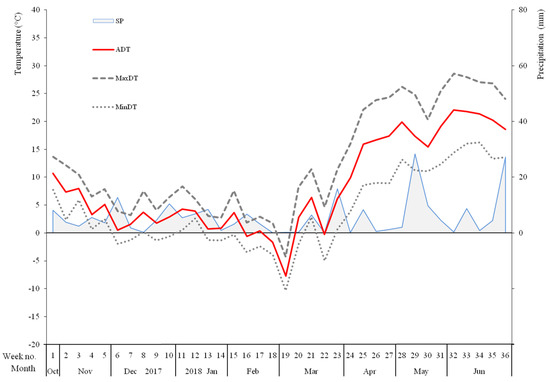
Figure 1.
The characteristics of weather conditions during the experiment period in Lednice location. ADT—average daily temperature; MinDT—minimal daily average temperature; MaxDT—maximal daily average temperature; SP—sum of precipitation; Week no—week number since planting.
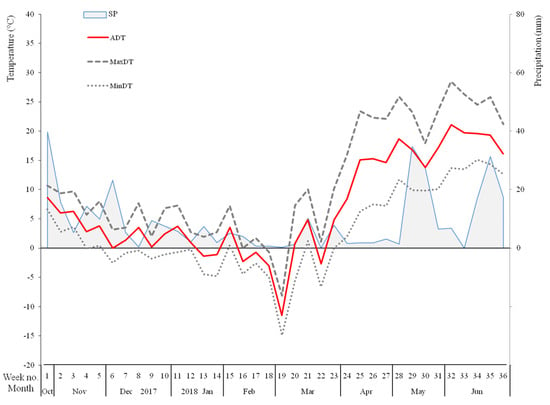
Figure 2.
The characteristics of weather conditions during the experiment period in Krakow location. ADT—average daily temperature; MinDT—minimal daily average temperature; MaxDT—maximal daily average temperature; SP—sum of precipitation; Week no.—week number since planting.
In Krakow and in Lednice, the experiment was located on soil classified as brown type (with loess as the basement complex in Krakow). The soil was deeply cultivated and fertile, with pH from slightly acidic to neutral (pH 6.1–6.8), electrical conductivity (EC) below 0.14 dS m−1 and organic matter content form 1.5–2.2%. Based on the soil analysis, the following fertilization in both locations was applied: N 2 × 50 kg/ha, P2O5: 45 kg/ha, K2O: 50 kg/ha.
2.4. Plant’s Parameters Measurement
In each term of bulb lifting, immediately after harvest, final bulb fresh weight (bulb FW) was estimated. Straight after, the following morphological parameters were measured: bulbs height (bulb H) and biggest diameter (bulb BD) (for the purpose of further calculations), leaf width (leaf W), length (leaf L) and total area (leaf TA), plants total length (plant TL). Leaf W was measured as the widest leaf width, leaf L as the longest leaf length including etiolated part and leaf TA as the sum of the green parts of leaf area of all leaves of the measured plant. Leaf TA was measured with WinDIAS 3.2. Leaf Image Analysis System (Delta-T Devices, Cambridge, UK). The system comprised a video camera pointing vertically down to an illuminated table and connected to a computer. After calibration to accuracy 0.01 cm2, WinDIAS-3 analyzed the colored threshold regions to measure leaf parameters. Plant TL was calculated as a sum of bulb H and leaf L values.
Afterward, plant material was washed and dried in a forced ventilation heater at 50 °C to constant weight. Dry weight of organs—root (root DW), bulbs (bulb DW) and leaves (leaf DW)—was measured on a digital scale with measurement accuracy 0.01 g. Plant total dry weight (plant TDW) was calculated by summing up root DW, bulb DW and leaf DW values.
On the basis of the obtained results, the bulb shape ratio (bulb S ratio) was estimated as bulb H-to-bulb BD ratio, and bulb weight increase indicator (bulb WI indicator) was calculated in accordance to Equation (1) below:
2.5. Statistical Analysis
Statistical analyses were performed using Statisica 13.3 software (TIBCO Software Inc., Palo Alto, CA, USA). In order to verify normality of data distribution, a Shapiro–Wilk test was applied. A combined analysis of variance (ANOVA) followed by Duncan’s honest significance test was used to determine the main effects of and interactions between the size group, lifting term and localization at the p ≤ 0.05 significance. To determine the relation between all studied traits, the Pearson’s correlation coefficient (r) was calculated. Simple regression analysis was performed for establishing the relationship between the initial bulb FW and the final bulb FW in particular lifting time. To evaluate the relationships between original variables on the basis of morphological and ratios traits, the principal component analysis (PCA) was performed (using standardized data). The first two components (PC1 and PC2) explaining the maximum variance in the datasets were used to generate plots.
3. Results and Discussion
3.1. Fresh and Dry Weight Organs Parameters
The effect of bulb size and lifting term on the quality of Narcissus poeticus propagation material have to our knowledge not been reported before. In this study, the analysis of the main effects proved that lifting term, bulb size, location and interactions between them significantly influenced dry and fresh weight of plant organs (Table 2).

Table 2.
Results of ANOVA for the analyzed parameters affected by lifting time, bulb size, localization and interactions.
In Lednice, the highest mean fresh weight (FW) was noticed for the bulbs from S11 and S12 size groups and lifted as the latest (S11-LT3 13.6 g; S12-LT3 14.0 g) (Figure 3). The lowest mean FW (1.3 g) was observed for the smallest bulbs lifted immediately after flowering (S1-LT1); however, it was not significantly different from FW of S1 bulbs group lifted two and four weeks after flowering. Within each size group S4–S12, the FW statistically increased with each other lifting term. Generally, along with increasing bulb size group and delaying lifting term, the DW of plant organs increased, but these differences were not always of statistical significance. The highest mean values for bulb DW (4.8 g), leaf DW (0.7 g) and plant TDW (6.1 g) were noticed for the combination S12-LT3, which, however, did not statistically differ from S11-LT3 combination. All mentioned parameters were the lowest for S1-LT1 bulbs (0.3 g; 0.08 g; 0.5 g), but in comparison to some other combinations, those values were statistically alike. Similar trends were observed in Krakow conditions (Figure 4). Most often, with the size of planted bulbs their FW increased after the bulb lifting. The highest mean value of bulb FW was obtained in combination S12-LT3 (10.7 g), while the lowest in S1-LT1/LT2/LT3 (1.4–1.7 g); however, it was significantly alike with the S2-LT1/LT2 combination. Within each bulb size group (except S1–S3), delaying the term of lifting resulted in statistically higher bulb FW. Similarly, the later the lifting term and the bigger the bulbs, the higher the dry weight (DW) of bulb and plant (TDW). The highest mean values of these parameters (3.85 g and 4.45 g, respectively) were indicated for S12-LT3 combinations, wherein plant TDW was not significantly different from S12-LT2. Bulb DW and plant TDW of S12-LT3 were 7–8 times higher than those noticed for S1-LT1/LT2/LT3. According to Rees [26], the decrease or increase of Narcissus bulb weight is related to the carbohydrate status of the plant. Moreover, the weight of harvested bulbs is higher in plants with more leaves (e.g., in Lilium) [27] and more leaves per plant are usually produced by larger bulbs than by smaller ones (e.g., in Lachenalia) [13]. In our study, an increase in leaf DW was observed along with an increase in the size of planted bulbs. However, this tendency was not of a model nature.

Figure 3.
Effect of size group and lifting term on measured DW and FW of organs parameters for Lednice (LE) location. Mean values within the same color with different letter are significantly different according to Duncan’s multiple range test at p ≤ 0.05. For treatments description, see Section 2.1, Section 2.2, Section 2.3 and Section 2.4, Materials and Methods sections.
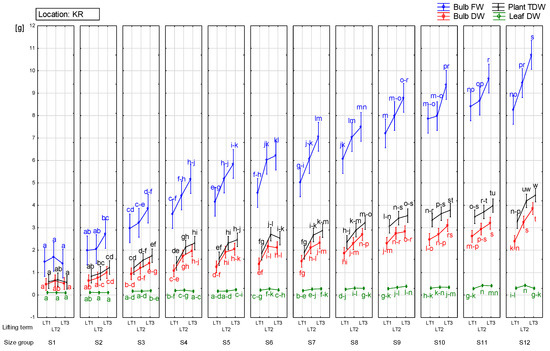
Figure 4.
Effect of size group and lifting term on measured dry weight of bulb (DW) and fresh weight of bulb (FW) of organs parameters for Krakow (KR) location. Mean values within the same color with different letters are significantly different according to Duncan’s multiple range test at p ≤ 0.05. For treatments description, see Section 2.1, Section 2.2, Section 2.3 and Section 2.4, Materials and Methods sections.
As reported [19], very early narcissus bulb lifting term or leaves defoliation conducted two to four weeks after flowering have a significant and detrimental effect on bulbs’ yields. Based on the results obtained, it can be hypothesized (stated) that in the case of the smallest bulbs (S1–S2), the date of lifting does not affect the value of the dry matter of the organs (which determines its quality), and therefore they can be lifted at any convenient time within 4 weeks from flowering. In the case of larger bulbs, the time of lifting is an important intervention—it is worth leaving the bulbs longer in the ground to get better quality organs. However, in determining the time of bulb lifting, weather conditions in the growing season should be taken into account. Prolonged moist periods favor the development of fungal diseases (e.g., Fusarium, Botrytis, Penicillium) which may infect narcissus bulbs staying too long in the ground [4]. Late bulb lifting may also increase viruses’ infections even by three-fold [28]. In view of the mentioned difficulties, the priority is the health of the material obtained, not its size.
Rees [29] indicated that during the spring development of N. pseudonarcissus “Fortune” and “Golden Harvest”, and N. poeticus “Actaea”, the curves of growth for bulb dry weight and total plant dry weight are close to parallel for all varieties. In the presented study, the noticed relation between those curves in the corresponding period of cultivation is similar, but not so obvious. The mentioned author, however, studied larger, round and double-nosed bulbs material, which suggests that in the case of smaller bulbs, the curves of growth for plant organs may be slightly different.
Root DW grew regularly as the size of the planted bulbs increased, reaching eight times higher values in the S12 group compared to the smallest bulbs of S1 (Figure 5). In the case of tulips, a similar tendency was observed—better quality of root system (roots length, weight and number) was typical for bigger bulbs [30]. In this study, the mean dry weight of roots developed by the bulbs lifted as the earliest was the lowest (0.21 g), whereas that produced by the plants lifted later (LT2–LT3) was about 20% higher compared to LT1. Such an increase of N. poeticus root DW may be explained by a large increase in fatty acids that was observed in the roots of N. pseudonarcissus towards the end of the season [31]. Strong and positive correlation between root DW and bulb weight parameters (FW, DW) was observed (r = 0.899 and r = 0.873, respectively, at p ≤ 0.01) (Table 3).

Figure 5.
Effect of size group and lifting term on root DW (g plant−1) for Lednice (LE) and Krakow (KR) locations. Mean values with different small letter within the location (LE or KR) as well as mean values with different large letter are significantly different according to Duncan’s multiple range test at p ≤ 0.05. For treatments description, see Section 2.1, Section 2.2, Section 2.3 and Section 2.4, Materials and Methods sections.

Table 3.
Pearson’s correlation coefficients among all studied parameters.
3.2. Morphological Parameters of Plants and Leaves
The impact of the studied factors was not as significant for plant TL and leaf L as it was for DW and FW parameters. In both locations, plant TL is strongly correlated with leaf L (Table 3, Figure 6, Figure 7). In Lednice, the tendency to increase leaf and plant TL with delaying the lifting term was most often observed. Results show that leaf W widens with increasing bulb size both in Lednice and Krakow, generally in accordance with the rule that the bigger the mother bulb, the wider the leaf. The interactions between leaf W and lifting term were noticed (Table 2), but no clear tendency can be defined.
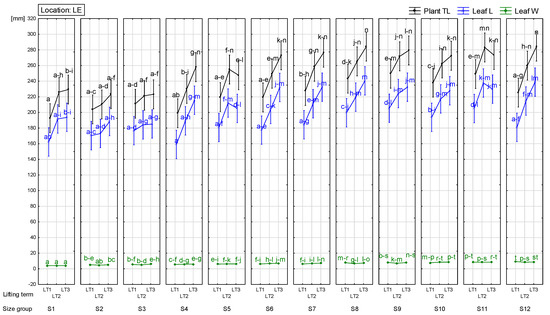
Figure 6.
Effect of size group and lifting term on morphological features of bulbs and leaf for Lednice (LE) location. Mean values within the same color with different letter are significantly different according to Duncan’s multiple range test at p ≤ 0.05. For treatments description, see Section 2.1, Section 2.2, Section 2.3 and Section 2.4, Materials and Methods sections.

Figure 7.
Effect of size group and lifting term on morphological features of bulbs and leaf for Krakow (KR) location. Mean values within the same color with different letter are significantly different according to Duncan’s multiple range test at p ≤ 0.05. For treatments description, see Section 2.1, Section 2.2, Section 2.3 and Section 2.4, Materials and Methods sections.
Taking into consideration the average results of leaf TA measurements from two locations, it was found that initially, larger bulbs gave rise to plants whose leaf TA increased more than in plants originating from initially smaller bulbs (Figure 8). This is in agreement with Rees et al. [32], who report that the bulb size determines the leaf area. Comparison of the results in the context of lifting term shows that the leaf TA value had been increasing up to two weeks after flowering (LT2) and decreasing afterwards, reaching the lowest level in LT3. In the period preceding the second term of bulb lifting (LT2), the highest values of leaf TA (LT2) (Figure 8) could have coincided with the peak of incoming solar radiation. Correlation coefficient indicated that leaf TA was positively associated with the most of attributes studied, except bulb WI indicator (Table 3). Moreover, that strong positive correlation with leaf TA concerned parameters connected with the quality of obtained bulbs (bulb FW, r = 0.819; bulb DW, r = 0.781; at p ≤ 0.01). These data agree with the results reported by Rees [17] and Weraduwage et al. [33] and indicate that leaf area growth is favorable for dry matter production and the light interception and may be used as the criterion of plant productivity. Our experiment shows that Narcissus poeticus leaves (TA) and roots (DW) exhibit active growth until two weeks from flowering, while growth of bulbs (DW, FW) still continues (Figure 3, Figure 4, Figure 5, Figure 6, Figure 7 and Figure 8).
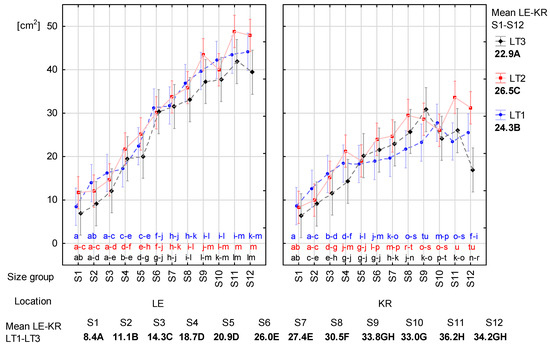
Figure 8.
Effect of size group and lifting term on leaf TA (cm2) for Lednice (LE) and Krakow (KR) location. Mean values with different small letter within the locations (LE or KR) as well as mean values with different large letter are significantly different according to Duncan’s multiple range test at p ≤ 0.05. For treatments description, see Section 2.1, Section 2.2, Section 2.3 and Section 2.4, Materials and methods sections.
3.3. Shape Ratio and Weight Indicator as Bulbs Quality Determinants
The bulb S ratio provides information about the shape of a bulb. Its value closer to 1 indicates an approximately round (globular) shape, whereas values receding from unity show bulb elliptical shape. Predominantly in both locations bulb, S ratio gradually decreases together with the increase of bulbs weight (higher size group) and later lifting term (Figure 9, Figure 10). Bigger bulbs have lower bulb S ratio values in comparison to the smaller bulbs. This trend is confirmed by correlation analysis, presented in Table 3, revealing a strong, negative relationship between the bulb S ratio and bulb FW (r = −0.776, p ≤ 0.01). Similarly, strong negative correlations occur in relations of bulb S ratio with root DW, bulb DW and plant TDW. The results discussed above correspond to the findings of Hanks [21], who claims that large round bulbs are obtained in one year from larger offsets, while small offsets need two or even three years to achieve a large round shape. According to Marques and Draper [34], bulb size (which in the case of narcissus is combined with the shape) indicates the degree of bulb maturity, and this feature is genotype-dependent. Moreover, Pütz [35] claims that illumination may play a role in determining bulb shape. The illumination of the basal parts of the leaf of N. tazzeta resulted in obtaining the bulbs with oval or elliptical shape, whereas in not illuminated plants, more globular bulb shape was observed. Additionally, in the present study, the initial bulbs of elliptical shape were able to flower (see Section 2) however only those of adequate high weight (4.8–6.3 g).
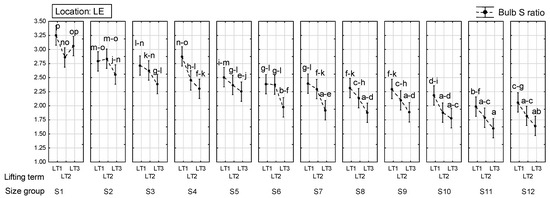
Figure 9.
Effect of size group and lifting term on bulb S ratios for Lednice (LE) location. Mean values with different letter are significantly different according to Duncan’s multiple range test at p ≤ 0.05. For treatments description, see Section 2.1, Section 2.2, Section 2.3 and Section 2.4, Materials and Methods sections.
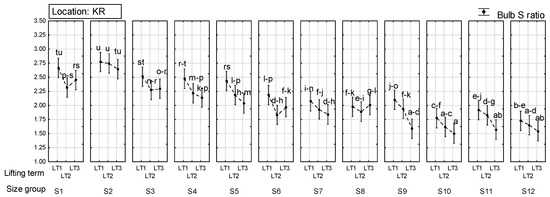
Figure 10.
Effect of size group and lifting term on bulb S ratios for Krakow (KR) location. Mean values with different letter are significantly different according to Duncan’s multiple range test at p ≤ 0.05. For treatments description, see Section 2.1, Section 2.2, Section 2.3 and Section 2.4, Materials and Methods sections.
The course of the bulb WI indicator values distribution for Lednice and Krakow is presented in Figure 11. In Krakow conditions, the values of this parameter obtained in the third lifting term were different from those determined in LT2 and LT1, however not always relevant. Results for Lednice revealed a similar tendency, and the observed differences were statistically significant. Bulb WI Indicator successively increased with delaying the lifting term. In both locations, bulb WI indicator parameters were twice as high in the third lifting term as those recorded in the LT1. Bulb WI indicator was significantly the highest (115.3%) for the smallest bulbs (S1) and the lowest (65%) for the biggest ones (S12). The latter mentioned value did not differ significantly from the ones recorded for the S11 (75%) and S10 (74.9%) bulbs. In practice, these results mean that the smallest bulbs increase their volume more than once, while larger by only more than half. Thus, the important practice is to wait with lifting the largest bulbs as their increase during the vegetative season is not too spectacular. Further results indicate a positive association of bulb WI indicator with leaf and total plant length as well as with leaf DW (r = 0.486, r = 0.452, r = 0.225 respectively at p ≤ 0.01) (Table 3). It has previously been proposed for some ornamental geophytes that the size of planting material is important for determining the increase in weight of bulbs—greater weight gain during the season was observed for smaller plant materials than for bigger ones [17,36,37]. A similar observation concerning higher values of bulb weight increase shown by smaller bulbs of Narcissus ’Fortune’ compared to larger ones was noticed by Fenlon et al. [38]. This relation turned out to be independent of method of propagation from which bulbs were obtained. This can be explained by the fact that larger bulbs are closer to achieve maximum final size than smaller ones [16].
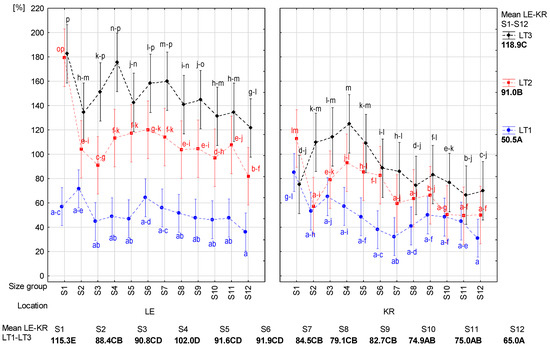
Figure 11.
Effect of size group and lifting term on bulb weight increase (WI) indicator (%) for Lednice (LE) and Krakow (KR) locations. Mean values with different small letter within the location (LE or KR) as well as mean values with different large letter are significantly different according to Duncan’s multiple range test at p ≤ 0.05. For treatments description, see Section 2.1, Section 2.2, Section 2.3 and Section 2.4, Materials and Methods sections.
The general remark that arises after analysis of all parameters presented in Section 3.1, Section 3.2 and Section 3.3 is that in both locations, similar tendencies were observed, although the values of particular parameters sometimes slightly differ between locations and were higher in Lednice. Subtle differences in the temperature and precipitation pattern could have affected the individual values of the studied parameters (Figure 1, Figure 2, Table S1).
3.4. Linear Response of the Bulb Fresh Weight (Bulb FW) under Different Lifting Terms (LT)
Linear response of the final bulb FW to the initial bulb fresh weight and the three different lifting terms are shown in Figure 12. When bulbs are lifted just after flowering (LT1) the final bulb FW is expected to increase by 1.36 of the initial bulb fresh weight, while lifted two (LT2) and four (LT3) weeks later, by 1.64 and 1.94, respectively. The R2 value showed that 97, 88 and 85% of variation in final bulb FW for subsequent lifting terms could be explained by a linear regression model.

Figure 12.
Linear regression analysis of the bulb initial fresh weight and post-harvest fresh weight (bulb FW) under different lifting term (LT1–LT3) conditions.
In the presented experiment, flowering bulbs weighted from 4.8 g (S9). Theoretically, considering the cultivation of small, for example 2 g, bulbs, based on the presented linear regression equations (Figure 12), delaying lifting term for 4 weeks enabled reaching the target weight for flowering bulb earlier. Thus, this approach may improve the production process, and from the point of view of producers, it is of great importance. However, as other authors report, each species, or even cultivar, may have specific critical bulb parameters for flowering [4,13,29,39,40].
3.5. Principal Components Analysis
Principal components analysis provides a new artificial variable (PCs) calculated on the basis of linear combinations of original variables [41]. In this study, the first two principal components evaluated for 11 tested traits identified 86.58% of total variability (Table 4, Figure 13). The other PCs, that had a minor effect on the model, were discarded. The first principal component (PC1) accounted for 70.24% of variance, while the PC2 16.34%. According to the loadings of variables, PC1 constituted variables correlated positively, such as bulb S ratio (r = 0.74) and negatively such as with plant TDW (r = −0.97), bulb FW (r = −0.98), bulb DW (r = −0.96), leaf DW (r = −0.95) and root DW (r = −0.90). The above correlations indicated the association of height values of bulb S ratio with low values of the remaining mentioned variables, in which along with increasing the first one the others decrease. Regarding the second principal component, positively correlated with bulb WI indicator (r = 0.79), leaf L (r = 0.62) and plant TL (r = 0.58) explained the maximum variance in PC2.

Table 4.
Component loading of 11 traits, eigen values, proportion of total variability represented by the first two principal components (PC), cumulative variability in narcissus bulbs.

Figure 13.
Principal components analysis outputs illustrated on a plot showing projected in the plane the position of variables as determined by the first two principal axes (explaining 86.58% of variance).
Figure 14 and Figure 15 show the location on the plane of the first two main components, presented in relation to bulb size group (S1–S12) and lifting term (LT1–LT3). Comparison of Figure 13 and Figure 14 and Figure 13, Figure 14 and Figure 15 enabled us to verify that observations were distributed near the vectors (variables) in accordance with the character of occurring interrelationships described in previous parts of the chapter.
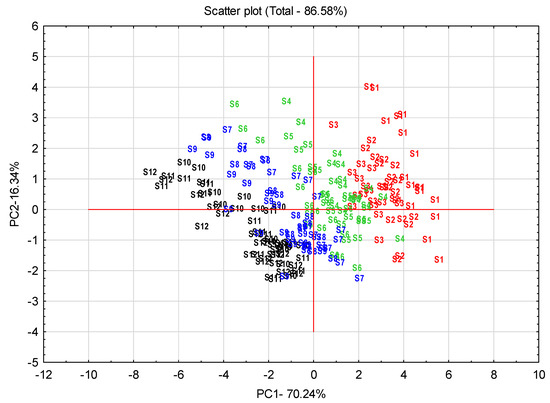
Figure 14.
Based on the principal component analysis (PCA), the configuration chart of observations illustrated in the system of the first two principal axes and showing interrelations among Narcissus poeticus plants’ of different bulb sizes. Observations are presented in the category of bulb size group S1–S12.
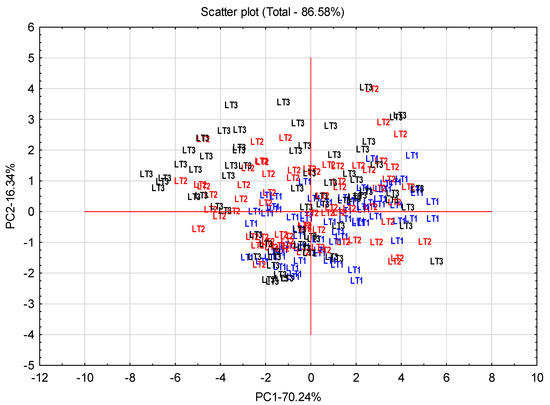
Figure 15.
Based on the principal component analysis (PCA), configuration chart of observations illustrated in the system of the first two principal axes, showing interrelations among Narcissus poeticus plants lifted at different terms. Observations are presented in the category of lifting term (LT1–LT3).
Although positive interaction of almost all studied features of plants with location factor was observed (Table 2), the similar tendency in growth and development of bulbs both in Lednice and Krakow may suggest that probably other factors besides environmental factors influenced plant behavior. According to Rees [29], the size of a bulb has a greater impact on the way of plants behavior during development process rather than other attributes such as a cultivar type. Seasonal changes in the primary and secondary metabolite profiles observed in the bulbs, leaves and roots which are involved in organogenesis processes, stress response, hormone transport, plant architecture and in many other phases of plant development [31] might have also influenced the obtained results.
4. Conclusions
In the presented study we proved that harvesting bulbs of Narcissus poeticus at an early time-point is possible; however, bulbs of a higher quality are obtained with the delay of the harvest date. Thus, taking into account the needs of the producers and consumers who expect to obtain plants of the highest quality, we recommend leaving the bulbs in the ground four weeks after flowering because they achieve the higher quality parameters. Derogation from this recommendation may apply to the bulbs with the smallest initial weight, on which the lifting term does not have as much impact as on larger bulbs. Of all studied factors, bulbs size appeared to determine the dynamics of plants growth and influence the final plant parameters the most. We found that root dry weight and leaf total area can be adopted as the criterion of plant productivity as they were positively correlated with bulb weight parameters. Based on the results presented here, a rule can be formulated—the smaller the mother bulb, the greater weight gain during the season. The obtained results relate to a moderate climate, which diverges from the optimal climatic conditions for N. poeticus. Such a climatic area of research broadens the knowledge about this species in an ecological and geographical context and may form part of new horticultural practices or the specialized protocols used for pharmaceutical or other industrial targets.
Supplementary Materials
The following are available online at https://www.mdpi.com/2073-4395/10/7/975/s1, Table S1: Detailed data on the climatic conditions during the experiment for two experiment locations: Lednice (LE) and Krakow (KR).
Author Contributions
Conceptualization, K.A.S. and A.J.; methodology, K.A.S. and A.J.; formal analysis, J.M. and A.K.; investigation, J.M., K.A.S. and A.J.; resources, K.A.S., A.J. and J.M.; writing—original draft preparation, A.K. and J.M.; writing—review and editing, A.K. and J.M.; visualization, J.M.; supervision, K.A.S. and A.K.; funding acquisition, A.J. and J.M. All authors have read and agreed to the published version of the manuscript.
Funding
This research was supported by the Ministry of Science and Higher Education of the Republic of Poland from subvention funds for University of Agriculture in Krakow and by the project CZ.02.1.01/0.0/0.0/16_017/0002334 Research Infrastructure for Young Scientists, this is co-financed from Operational Programme Research, Development and Education.
Conflicts of Interest
The authors declare no conflict of interest.
References
- Mathew, B. Classification of the genus Narcissus. In Narcissus and Daffodil. The Genus Narcissus; Hanks, G.R., Ed.; Taylor & Francis: London, UK, 2002; pp. 30–52. [Google Scholar]
- Okubo, H.; Sochacki, D. Botanical and horticultural aspects of major ornamental geophytes. In Ornamental Geophytes. From Basic Science to Sustainable Production; Kamenetsky, R., Okubo, H., Eds.; CRC Press: Boca Raton, FL, USA, 2012; pp. 77–121. [Google Scholar]
- Gul, F.; Shahri, W.; Tahir, I. Morphological and some biochemical aspects of flower development and senescence in Narcissus poeticus cv. Pheasant’s Eye. Int. J. Adv. Res. Sci. Eng. Technol. 2018, 7, 1745–1752. [Google Scholar]
- Thakur, P.; Misra, R.L.; Misra, S. Narcissus. In Commercial Ornamental Crops: Cut Fowers; Misra, R.L., Misra, S., Eds.; Kruger Brentt Publishers UK. LTD.: Middlesex, UK, 2017; pp. 373–388. [Google Scholar]
- Šafratová, M.; Hostalková, A.; Hulcová, D.; Breiterová, K.; Hrabcová, V.; Machado, M.; Fontinha, D.; Prudêncio, M.; Kuneš, J.; Chlebek, J.; et al. Alkaloids from Narcissus poeticus cv. Pink Parasol of various structural types and their biological activity. Arch. Pharm. Res. 2018, 41, 208–218. [Google Scholar] [CrossRef] [PubMed]
- Lubbe, A.; Pomahačová, B.; Choi, Y.H.; Verpoorte, R. Analysis of metabolic variation and galanthamine content in Narcissus bulbs by1H NMR. Phytochem. Anal. 2009, 21, 66–72. [Google Scholar] [CrossRef]
- Umarov, A.A.; Mustaev, F.A.; Zhauynbaeva, K.S. Protective and stimulating activity of glucomannan from Narcissus poeticus. Russ. Agric. Sci. 2009, 35, 394–397. [Google Scholar] [CrossRef]
- Ehret, C.; Maupetit, P.; Petrzilka, M. New organoleptically important constituents of narcissus absolute (Narcissus poeticus L.). J. Essent. Oil Res. 1990, 4, 41–47. [Google Scholar] [CrossRef]
- Remy, C. Narcissus in perfumery. In Narcissus and Daffodil. The Genus Narcissus; Hanks, G.R., Ed.; Taylor & Francis: London, UK, 2002; pp. 392–398. [Google Scholar]
- Chwil, M. Ecology of flowers and morphology of pollen grains of selected Narcissus varieties (Narcissus pseudonarcissus × Narcissus poëticus). Acta Agrobot. 2006, 59, 107–122. [Google Scholar] [CrossRef][Green Version]
- Le Nard, M.; De Hertogh, A.A. Bulb growth and development and flowering. In The Physiology of Flower Bulbs; De Hertogh, A.A., Le Nard, M., Eds.; Elsevier Science Publishers B.V.: Amsterdam, The Netherlands, 1993; pp. 29–43. [Google Scholar]
- Khodorova, N.V.; Boitel-Conti, M. The role of temperature in the growth and flowering of geophytes. Plants 2013, 2, 699–711. [Google Scholar] [CrossRef]
- Kapczyńska, A. Effect of bulb size on growth, flowering and bulb formation in lachenalia cultivars. Hort. Sci. (Prague) 2014, 41, 89–94. [Google Scholar] [CrossRef]
- Salachna, P. Effect of bulbs size on the inflorescences and bulbs yield of Ornithogalum saundersiae Baker grown in an unheated plastic tunnel. Folia Pomer. Univ. Technol. Stetin. Agric. Aliment. Pisc. Zootech. 2014, 31, 153–158. [Google Scholar]
- Manimaran, P.; Ghosh, S.; Priyanka, R. Bulb size and growth regulators on the growth and performance of bulbous ornamental crops-A review. Chem. Sci. Rev. Lett. 2017, 6, 1277–1284. [Google Scholar]
- Özel, A.; Erden, K. The effect of bulb sizes on the bulb yield and some plant characteristics of Narcissus tazetta subsp. tazetta L. Harran Tarım Gıda Bilimleri Derg. 2018, 22, 355–362. [Google Scholar] [CrossRef]
- Rees, A.R. The physiology of ornamental bulbous plants. Bot. Rev. 1966, 32, 1–23. [Google Scholar] [CrossRef]
- Wright, P.J.; Burge, G.K.; Triggs, C.M. Effects of cessation of irrigation and time of lifting of tubers on bacterial soft rot of calla (Zantedeschia spp.) tubers. N. Z. J. Crop Hortic. Sci. 2002, 30, 265–272. [Google Scholar] [CrossRef]
- Hanks, G.R. Narcissus. In The Physiology of Flower Bulbs; De Hertogh, A.A., Le Nard, M., Eds.; Elsevier Science Publishers B.V.: Amsterdam, The Netherlands, 1993; pp. 463–558. [Google Scholar]
- Le Nard, M.; De Hertogh, A.A. Research needs for flower bulbs (geophytes). Acta Hortic. 2002, 570, 121–127. [Google Scholar] [CrossRef]
- Hanks, G.R. Commercial production of Narcissus bulbs. In Narcissus and Daffodil. The Genus Narcissus; Hanks, G.R., Ed.; Taylor & Francis: London, UK, 2002; pp. 54–131. [Google Scholar]
- Podwyszyńska, M.; Skrzypczak, C.; Fatel, K.; Michalczuk, L. Study on usability of Fusarium oxysporum Schlecht.f.sp. tulipae Apt. metabolites for screening for basal rot resistance in tulip. Acta Agrobot. 2013, 54, 71–82. [Google Scholar]
- Hanks, G.R. Narcissus Manual; Horticultural Development Company: Stoneleigh, UK, 2013; p. 223. [Google Scholar]
- Dana, M.N.; Lerner, B.R. The Narcissus (HO-11-W). Purdue University Cooperative Extension Service. 2001. Available online: https://www.purdue.edu/hla/sites/yardandgarden/wp-content/uploads/sites/2/2016/10/HO-11.pdf (accessed on 26 March 2020).
- Peel, M.C.; Finlayson, B.L.; McMahon, T.A. Updated world map of the Köppen-Geiger climate classification. Hydrol. Earth Syst. Sci. 2007, 11, 1633–1644. [Google Scholar] [CrossRef]
- Rees, A.R. The initiation and growth of Narcissus bulbs. Ann. Bot. 1969, 33, 277–288. [Google Scholar] [CrossRef]
- Xia, Y.P.; Zheng, H.J.; Huang, C.H. Studies on the bulb development and its physiological mechanisms in Lilium oriental hybrids. Acta Hortic. 2005, 673, 91–98. [Google Scholar] [CrossRef]
- Mowat, W.P. Epidemiological studies on viruses infecting narcissus. Acta Hortic. 1980, 109, 461–467. [Google Scholar] [CrossRef]
- Rees, A.R. The Growth of Bulbs: Applied Aspects of the Physiology of Ornamental Bulbous Crop Plant, 1st ed.; Academic Press, Inc.: London, UK, 1972; pp. 45–113. [Google Scholar]
- Kawa, L.; De Hertogh, A.A. Root physiology of ornamental flowering bulbs. In Horticultural Reviews; Janick, J., Ed.; John Wiley & Sons, Inc.: Hoboken, NJ, USA, 1992; Volume 14, pp. 57–88. [Google Scholar]
- Lubbe, A.; Gude, H.; Verpoorte, R.; Choi, Y.H. Seasonal accumulation of major alkaloids in organs of pharmaceutical crop Narcissus Carlton. Phytochemistry 2013, 88, 43–53. [Google Scholar] [CrossRef]
- Rees, A.R.; Wallis, L.W.; Tompsett, A.A. Effects of planting density, plant arrangement and frequency of lifting on flower and bulb production of Narcissus in S.W. England. J. Hortic. Sci. 1973, 48, 59–73. [Google Scholar] [CrossRef]
- Weraduwage, S.M.; Chen, J.; Anozie, F.C.; Morales, A.; Weise, S.E.; Sharkey, T.D. The relationship between leaf area growth and biomass accumulation in Arabidopsis thaliana. Front. Plant Sci. 2015, 6, 1–21. [Google Scholar] [CrossRef]
- Marques, I.; Draper, D. Decoupling of reproduction and growth: An unusual pattern in the life cycle of the Mediterranean geophyte Narcissus serotinus. Plant Spec. Biol. 2012, 27, 106–109. [Google Scholar] [CrossRef]
- Pütz, N. Underground plant movement: IV. Observance of the behaviour of some bulbs with special regard to the induction of root contraction. Flora 1996, 191, 313–319. [Google Scholar] [CrossRef]
- Addai, I.K.; Scott, P. Influence of bulb sizes at planting on growth and development of the common hyacinth and the lily. Agric. Biol. J. N. Am. 2011, 2, 298–314. [Google Scholar] [CrossRef]
- Kapczyńska, A. Effect of chipping and scoring techniques on bulb production of Lachenalia cultivars. Acta Agrobot. 2019, 72, 1–8. [Google Scholar] [CrossRef]
- Fenlon, J.S.; Jones, S.K.; Hanks, G.R.; Langton, F.A. Bulb yields from narcissus chipping and twin-scaling. J. Hortic. Sci. 1990, 65, 441–450. [Google Scholar] [CrossRef]
- Fortanier, E.J. Reviewing the length of the generation period and its shortening, particularly in tulips. Sci. Hortic. 1973, 1, 107–116. [Google Scholar] [CrossRef]
- Dafni, A.; Cohen, D.; Noy-Mier, I. Life-cycle variation in geophytes. Ann. Mo. Bot. Gard. 1981, 68, 652–660. [Google Scholar] [CrossRef]
- Saporta, G.; Keita, N.N. Principal Component Analysis: Application to Statistical Process Control. In Data Analysis; Govaert, G., Ed.; ISTE Ltd.-John Wiley & Sons, Inc.: London, UK; Hoboken, NJ, USA, 2009; pp. 1–23. [Google Scholar]
© 2020 by the authors. Licensee MDPI, Basel, Switzerland. This article is an open access article distributed under the terms and conditions of the Creative Commons Attribution (CC BY) license (http://creativecommons.org/licenses/by/4.0/).